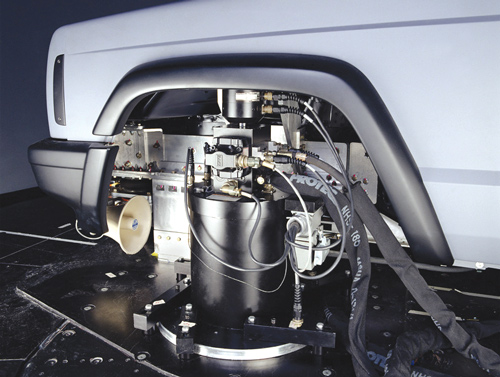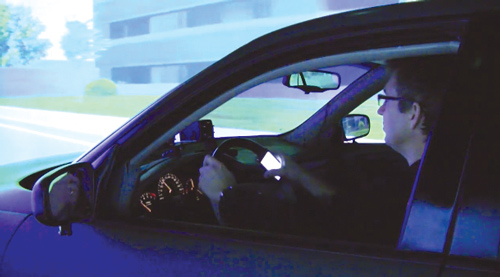|
|
THE NATIONAL ADVANCED DRIVING SIMULATOR (NADS)
The National Advanced Driving Simulator (NADS) is the most sophisticated research driving simulator in the world. Developed by the National Highway Traffic Safety Administration, the NADS offers high fidelity, real time driving simulation. It consists of a large dome in which entire cars and the cabs of trucks and buses can be mounted. The vehicle cabs are equipped electronically and mechanically using instrumentation specific to their make and model. At the same time, the motion system on which the dome is mounted will provide 400 square meters of horizontal and longitudinal travel and nearly 360 degrees of rotation in either direction. The effect will be that the driver will feel acceleration, braking and steering cues as if he or she were actually driving a real car, truck or bus. The latest in visual display technology and a high fidelity audio system will complete the driving experience. The test subject will be immersed in sight, sound and movement so real that impending crash scenarios can be convincingly presented with no danger to the subject. Vehicle and driver data can be accurately gathered and stored and tests repeated with exactitude. TRW was awarded the construction contract after winning the design competition conducted by NHTSA. TRW assembled a world class team that incorporated the latest in simulation technology in all aspects of the design for the $50 million project. The team included Dynamic Research, Inc., Evans & Sutherland, I*SIM and MTS Systems. The NADS is located at the University of Iowa's Oakdale Research Park, Iowa City, IA. The site was selected as a result of a national competition among major transportation research universities conducted for NHTSA by the National Science Foundation. The University of Iowa provided $11.58 million in cost sharing to the NADS project which included the design and construction of a $5.7 million building to house the simulator. The effects of alcohol, drugs, visual impairments and aging on driving will all be safely studied using the new research tool. The NADS will provide the capability for evaluating advanced vehicle communication, navigation and control technologies which are now being developed as part of the Intelligent Transportation System (ITS) program. The medical community will look to the NADS to answer questions about the development and effects of new medicines and prosthetics on driving. Car companies can use the NADS to develop and test new safety devices in conjunction with their own simulators. Human factors issues, estimated to be a contributing cause of 90 percent of motor vehicle accidents, will finally be able to be studied in a safe, accurate and repeatable environment.
The National Advanced Driving Simulator (NADS) is a research tool that will be used to conduct fundamental research into the operation of the complex driver-vehicle-environment system. Of the three elements of this system, the driver is unique as the single element that is non-deterministic, i.e., driver behavior defies description or prediction by means of common physical laws. As a consequence, the only practical means of studying driver behavior is by means of direct observation. The most valid method of conducting such research is to make observations while the driver is engaged in the actual driving task, in a real vehicle, operating on a real highway. However, many such experiments cannot be conducted without exposing the driver to unacceptable physical danger. Under these restrictions, the study of driver response during critical crash avoidance situations becomes a practical impossibility.
A look inside the NADS-1 simulator dome
The NADS provides the capability for safely evaluating advanced vehicle communication, navigation, and control technologies which are now being developed as part of the Intelligent Transportation System (ITS) program. Important questions regarding the effect of these systems on driver workload, attention, behavior, and overall safety need to be addressed during the development phase. It is imperative to determine beforehand whether any of these advanced systems will have an unintended or detrimental impact on driver performance or highway safety. The NADS provides the means by which such experimental data can be generated. A clear understanding of driver behavior under these circumstances will lead the way to developing effective strategies and countermeasures for improved crash avoidance and reduced injuries and fatalities. The NADS also will provide a powerful and cost effective tool for conducting highway engineering and design research related to traffic safety. Since the driving scene and highway geometry are under the complete control of the simulator programmer, highway researchers will be able to evaluate alternative designs for intersections, entrances and exits, tunnel and bridge alignments, traffic control devices and highway signing without incurring the prohibitive expense of actual construction. The NADS will be dedicated primarily to advancing the cause of improved highway safety and efficiency. As a national research facility, the simulator is accessible to the widest possible spectrum of researchers from both the public and private sectors. The Department of Transportation has located the NADS at the University of Iowa who will be responsible for the daily operational research, maintenance, and long term upgrading of the NADS.
High-frequency actuators are used on the NADS-1 to recreate road effects.
© 2013 TLC Magazine Online, Inc. |





